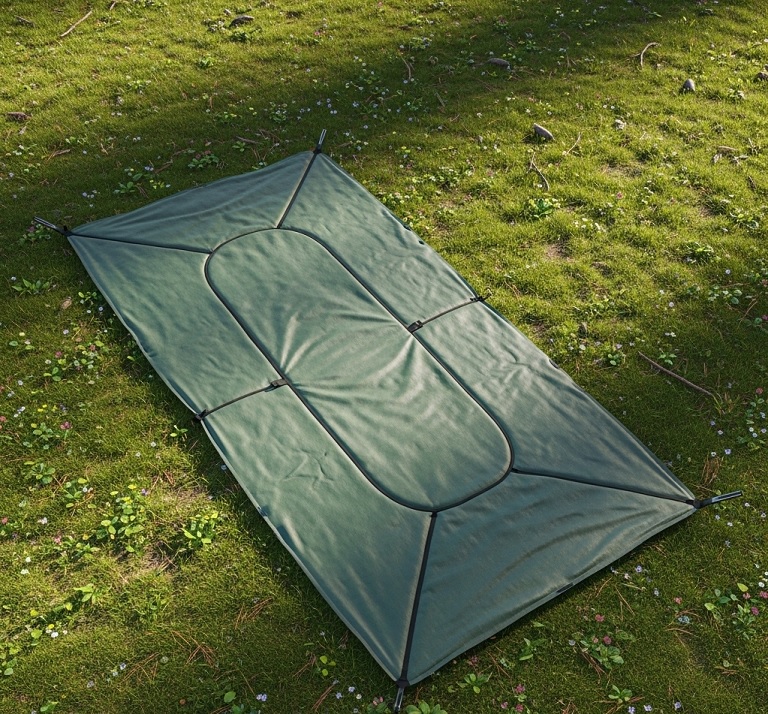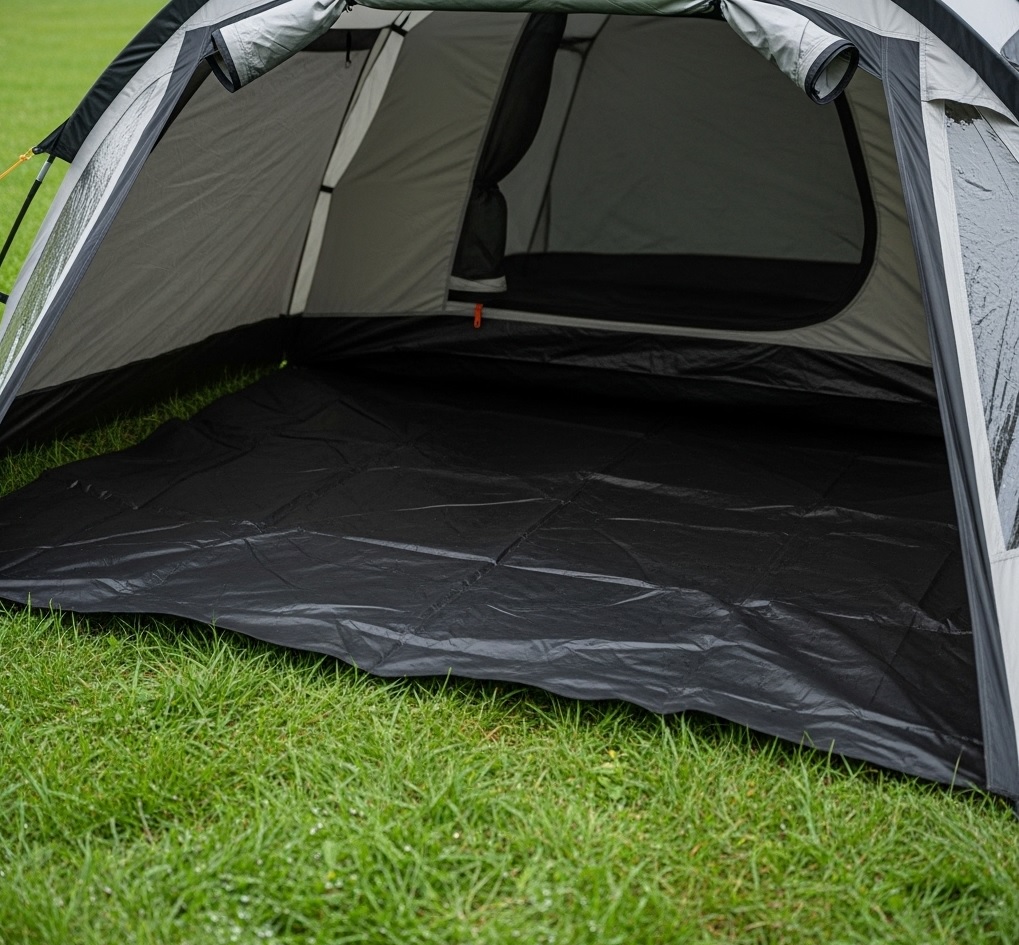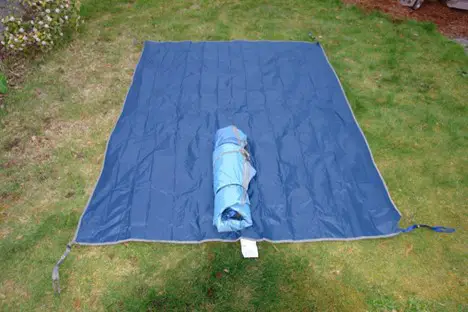This blog post may contain affiliate links. As an Amazon Associate I earn from qualifying purchases.
Imagine you’re setting up camp, eager to enjoy nature’s beauty and tranquility. But as you lay down your tent, you’re met with the harsh reality of rough terrain, damp ground, and unexpected wear and tear.
This is where a tent footprint comes to the rescue. Have you ever wondered how seasoned campers keep their tents in pristine condition despite unpredictable weather and rugged grounds? The secret lies in this simple yet essential piece of camping gear.
Discover what a tent footprint is and why it’s a must-have for every outdoor enthusiast. By the end of this article, you’ll know exactly how it can enhance your camping experience, saving you both time and money. Let’s delve into the details and see how this small addition can make a big difference.
Tent Footprint Basics

Every camper knows the importance of keeping their tent in good shape. A tent footprint is an essential part of your camping gear. It acts as a protective layer between your tent and the ground. This simple piece of fabric can make a big difference in your camping experience. It ensures tent protection, enhances durability, and eases campsite preparation.
What Is A Tent Footprint?
A tent footprint is a ground cover designed to fit under your tent. It’s usually made of lightweight materials like polyester or nylon. Think of it as a custom-sized tarp. It protects the bottom of your tent from rocks, sticks, and other debris. It is an important part of tent maintenance.
Why Use A Tent Footprint?
The main reason is tent protection. A footprint shields your tent from wear and tear. It acts as a moisture barrier, keeping the tent floor dry. This is crucial in wet conditions. A footprint also helps in campsite preparation. It marks the area where your tent will be set up.
Benefits Of A Tent Footprint
- Durability: Extends the life of your tent by reducing ground abrasion.
- Moisture Protection: Keeps water from seeping into the tent floor.
- Easy Setup: Helps in easy campsite preparation by outlining the tent area.
When selecting a tent footprint, consider the size and shape of your tent. It should be slightly smaller than the tent floor. This prevents water from pooling between the footprint and tent. Look for lightweight materials that are easy to pack with your outdoor gear.
How To Use A Tent Footprint?
- Lay the footprint on the ground where you plan to pitch your tent.
- Align the edges of the footprint with the tent floor.
- Ensure it does not extend beyond the tent’s perimeter to avoid water pooling.
Benefits Of Using A Footprint

A tent footprint is a protective layer that lies beneath your tent. It acts as a barrier between your tent and the ground. This simple piece of gear can make camping more comfortable and extend the life of your tent. Let’s explore the benefits of using a footprint.
Protection From Ground Elements
A footprint offers protection from ground elements that can damage your tent. Rocks, twigs, and sharp objects can puncture the tent floor. A footprint shields against such hazards.
- Moisture Barrier: Keeps water from seeping into your tent. This is essential in damp environments.
- Thermal Insulation: Provides a layer between you and the cold ground. Helps maintain warmth inside the tent.
- Debris Shield: Prevents dirt and mud from sticking to your tent. Easier to clean and pack.
Using a footprint means less wear and tear on your tent. You can set up camp on rough terrain without worry. Enjoy nature without compromising comfort.
Enhanced Tent Longevity
Footprints enhance the longevity of your tent. Regular exposure to ground elements can degrade a tent’s floor. A footprint reduces direct contact.
- Reduces Abrasion: Minimizes friction between the tent and ground. Less wear means a longer-lasting tent.
- Protects Investment: Tents are costly. Footprints help protect your investment by prolonging tent life.
- Easy Replacement: It’s cheaper to replace a footprint than a tent. They bear the brunt of damage.
| Feature | Benefit |
|---|---|
| Durability | Increases tent lifespan |
| Cost Efficiency | Footprints are affordable |
Investing in a footprint saves money over time. It ensures your tent remains in good condition for many adventures.
Weight Considerations
Footprints come with weight considerations. Choosing the right footprint affects portability.
While some campers prioritize lightweight gear, footprints add minimal weight. They are made of durable yet lightweight materials.
- Material Options: Footprints are available in different materials. Choose nylon for lightweight or vinyl for durability.
- Size Matters: Footprints come in various sizes. Select one that fits your tent without excess material.
- Packing Ease: Foldable and compact designs make storage easy.
Opt for a footprint that balances durability and portability. It’s a small addition that makes a big impact. Carrying a footprint enhances your camping experience without burdening your backpack.
Read More: Essential Tent Camping Gear Checklist
Choosing The Right Footprint
Last update on 2025-10-19 / Affiliate links / Images from Amazon Product Advertising API
A tent footprint is a valuable piece of camping gear designed to protect the base of your tent. It acts as a barrier against moisture, dirt, and sharp objects. Choosing the right footprint ensures that your tent remains in top condition and extends its lifespan. The right footprint enhances ground protection, offering a smooth camping experience. In this section, we’ll explore how to choose the best tent footprint for your needs.
Material Options
The material of your tent footprint plays a significant role in its effectiveness. Different materials offer varying levels of durability and weight. Here are some common material options:
- Polyethylene: This is a heavy-duty option known for its waterproof qualities. It’s ideal for rainy conditions.
- Silnylon: Lightweight and compact, perfect for backpacking essentials. It provides a good balance of durability and portability.
- Tyvek: Known for its affordability and durability. It’s resistant to water and tears, making it a popular choice.
A table below summarizes these materials:
| Material | Durability | Weight | Waterproof |
|---|---|---|---|
| Polyethylene | High | Heavy | Yes |
| Silnylon | Medium | Light | Yes |
| Tyvek | High | Light | Yes |
Size Compatibility
Ensuring size compatibility is crucial when selecting a tent footprint. A footprint that is too large or too small can lead to problems.
Consider these tips for finding the right size:
- Measure your tent: Find the exact dimensions of your tent floor. This helps in selecting a footprint that fits perfectly.
- Check manufacturer recommendations: Many outdoor equipment brands suggest specific footprints for their tents.
- Leave some space: The footprint should be slightly smaller than your tent floor. This prevents water from collecting between the tent and the footprint.
Proper size compatibility ensures effective ground protection and extends the life of your tent.
Custom Vs. Generic Footprints
When choosing between a custom tent footprint and a generic footprint, consider your camping needs and budget.
Custom Tent Footprint:
- Designed specifically for your tent model.
- Offers perfect size compatibility and fit.
- Usually more expensive but provides excellent protection.
Generic Footprint:
- Suitable for various tent models.
- More affordable and versatile.
- May require adjustments for perfect fit.
Both options have their advantages. Custom footprints offer tailored protection, while generic ones provide flexibility. Consider your camping habits and decide which option best suits your outdoor adventures.
How To Use A Footprint?
A tent footprint is a protective layer that goes under your tent. It shields the tent floor from wear and tear. Using a footprint extends the life of your tent by preventing damage from rocks, sticks, and moisture. This is essential for campers who want their gear to last. But, how do you use a footprint effectively? Let’s dive into the details.
Setup Process
Setting up a tent footprint is a straightforward task. It involves a few easy steps to ensure your tent has the best protection. Here’s how:
- Unfold the Footprint: Spread it out on the ground where you plan to pitch your tent.
- Align with the Tent Base: Make sure it matches the shape of your tent floor. It should be slightly smaller to prevent water pooling between the tent and footprint.
- Smooth Out Wrinkles: Flatten any creases to ensure an even layer.
- Stake Down if Possible: Use stakes to secure the footprint if your model allows for it. This prevents it from shifting.
Using a footprint correctly ensures maximum durability. This simple step helps in keeping your tent clean and dry.
Positioning Tips
Correct positioning of the tent footprint can make a big difference. It ensures better protection and comfort. Here are some tips:
- Choose Flat Ground: Look for an even surface. This prevents rocks from poking through and damaging the tent.
- Avoid Water Flow Areas: Do not place your tent in depressions where water can collect.
- Consider Wind Direction: Position your tent so the door faces away from the wind. This protects against strong gusts.
A well-positioned footprint keeps your tent stable. It also minimizes contact with sharp objects.
Maintenance And Care
Keeping your tent footprint in good condition is important. Proper care extends its life and ensures it works well.
- Clean After Use: Wipe off dirt and debris before packing. This prevents mold and stains.
- Dry Before Storage: Make sure it is completely dry to avoid mildew.
- Store Properly: Fold it neatly and store in a cool, dry place.
- Inspect for Damage: Look for tears or holes regularly. Repair small damages promptly to avoid larger issues.
Regular maintenance keeps your footprint ready for future adventures. A well-cared-for footprint provides reliable protection.
Common Misconceptions
Camping enthusiasts often wonder about the necessity of a tent footprint. This simple piece of camping gear can extend the life of your tent. It’s a protective layer that goes under your tent, shielding it from rough terrain and moisture. Despite its usefulness, many campers have misconceptions about tent footprints. These misunderstandings can lead to inadequate tent protection. Let’s explore some common misconceptions.
Footprint Vs. Ground Cloth
Many campers confuse a tent footprint with a ground cloth. While both serve as protective layers, they are not the same. A tent footprint is specifically designed for your tent’s shape and size. It offers precise protection. In contrast, a ground cloth is a generic piece of material. It’s not tailored to fit your tent.
Here are some key differences:
- Fit: A tent footprint matches your tent’s dimensions. A ground cloth may extend beyond the tent, collecting rainwater.
- Material: Tent footprints use durable, waterproof material. Ground cloths might not be waterproof.
- Protection: Footprints provide better tent protection. They minimize wear and tear from rocky surfaces.
Understanding these differences helps in choosing the right camping accessories. It ensures that your outdoor equipment functions effectively. Proper tent maintenance starts with the right base layer.
Weight Vs. Durability
Another misconception involves the weight and durability of a tent footprint. Some campers believe a lighter footprint means better weight savings. While weight is important, durability should not be overlooked.
Consider these factors:
- Material Thickness: Thicker footprints offer more protection but can weigh more.
- Weather Conditions: In harsh weather, a durable footprint shields the tent better.
- Terrain Type: Rough terrains require sturdy footprints to prevent damage.
Balancing weight and durability is crucial. A lightweight footprint may save a few ounces but could compromise tent protection. Investing in a durable footprint ensures longevity of your camping gear. It offers peace of mind during outdoor adventures.
When To Skip The Footprint?
A tent footprint acts as a protective layer between your tent and the ground. It’s often used to extend the life of your tent, offering a waterproof barrier and preventing wear and tear. But you don’t always need one. Choosing when to skip the footprint can save you weight and effort during your outdoor adventures. Let’s explore scenarios when you might leave your tent footprint behind.
Camping On Solid Surfaces
Camping on solid surfaces like concrete or wooden platforms means you can skip the tent footprint. These surfaces don’t harm the tent fabric much. Here are some reasons why:
- Durable Surface: Solid surfaces don’t have sharp objects that could pierce the tent.
- Waterproof Barrier: Most platforms provide a natural waterproof barrier, reducing the need for extra protection.
- Ease of Setup: Without a footprint, campsite setup becomes faster and simpler.
Skipping the footprint also aids in tent maintenance. Less weight means less strain on your camping gear. The focus shifts to other backpacking essentials, making your outdoor gear more streamlined. Consider the following table for a quick overview:
| Considerations | Benefits |
|---|---|
| Durable Surface | Less risk of damage |
| Waterproof Barrier | Natural protection |
| Ease of Setup | Quick and simple |
Lightweight Backpacking
Lightweight backpacking prioritizes minimalism and efficiency. Skipping the tent footprint can help achieve a lighter pack. Here’s why:
- Weight Reduction: Eliminating the footprint reduces pack weight, crucial for long treks.
- Simplified Packing: Fewer items lead to streamlined backpacking essentials.
- Ground Tarp Alternative: A simple ground tarp can replace the footprint if needed.
Focusing on lightweight camping means every ounce counts. Tent protection can still be maintained with careful campsite setup. Opt for locations with natural grass or leaves. These offer some cushioning without the need for a footprint. Evaluate your outdoor gear priorities, ensuring efficient travel and tent maintenance. Here’s a brief comparison:
| Factors | Advantages |
|---|---|
| Weight Reduction | Less strain during hikes |
| Simplified Packing | Efficient use of space |
| Ground Tarp | Alternative protection |
Also Read: 10 Best Tent Waterproofing Spray
Frequently Asked Questions
What Is The Point Of A Tent Footprint?
A tent footprint protects your tent floor from damage and moisture. It increases durability and extends tent life. The footprint acts as an extra layer against rough surfaces. It helps keep the tent clean and dry, enhancing comfort during camping trips.
What Is A Footprint Used Under A Tent To Do?
A footprint under a tent protects the tent floor from abrasion and moisture. It enhances durability and insulation. By creating a barrier between the ground and the tent, it also makes cleaning easier. Compact and lightweight, it’s essential for maintaining your tent’s longevity and comfort during camping trips.
What Can You Use As A Substitute For Tent Footprint?
You can use a tarp, Tyvek sheet, or plastic sheeting as a tent footprint substitute. These materials provide protection from moisture and abrasions. Ensure the substitute is slightly smaller than your tent to prevent water pooling. Always choose durable and lightweight options for easy packing and setup.
Which Side Of The Tent Footprint Goes Up?
Place the shiny or coated side of the tent footprint up. This side is usually waterproof and designed to face the tent, providing better protection from ground moisture. Check the manufacturer’s instructions for confirmation, as designs can vary.
Conclusion
Choosing a tent footprint can make camping more enjoyable. It protects your tent from sharp objects and keeps it dry. Easy to set up. Lightweight and portable. A smart investment for any camping trip. It extends your tent’s lifespan. Saves you money in the long run.
Comfort and peace of mind on the trail. Many sizes and materials available. Find one that fits your needs. A must-have for outdoor enthusiasts. Experience better camping today.






